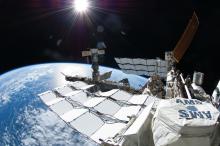Anti-Stars [1]
If you bring your starship out of warp drive close to an unexplored star, be careful. There’s a slim chance it could be an anti-star — a star made of antimatter.
Antimatter is the oppositely charged counterpart of normal matter. When matter and antimatter meet, they destroy each other in a burst of energy. Other than the charge, though, they’re just alike. So from afar, it’s almost impossible to tell a normal star from an anti-star.
In fact, there probably shouldn’t be any antimatter stars at all. Matter and antimatter were made in the Big Bang. Today, all we see for sure is normal matter. The antimatter appears to have been cancelled out in the early universe.
But a few years ago, an experiment in space caught a few possible bits of antimatter. So astronomers went looking for a source.
They looked for unusual sources of gamma rays — the energy produced when matter and antimatter collide. And they found 14 candidate stars.
Based on that number, the researchers estimated there could be up to one antimatter star for every 400,000 normal stars in the galaxy’s disk. That could yield a total of a quarter of a million to one million anti-stars in the disk. And there could be even more anti-stars in the galaxy’s halo, outside the disk.
The candidate objects may well turn out to be something besides antimatter stars. Just in case, though, it may be a good idea to keep your shields up when you visit an unexplored star.
Script by Damond Benningfield
Keywords:
- Gamma-Ray Astronomy [3]
- Milky Way Galaxy [4]
- Particle Physics [5]
- Stars [6]


